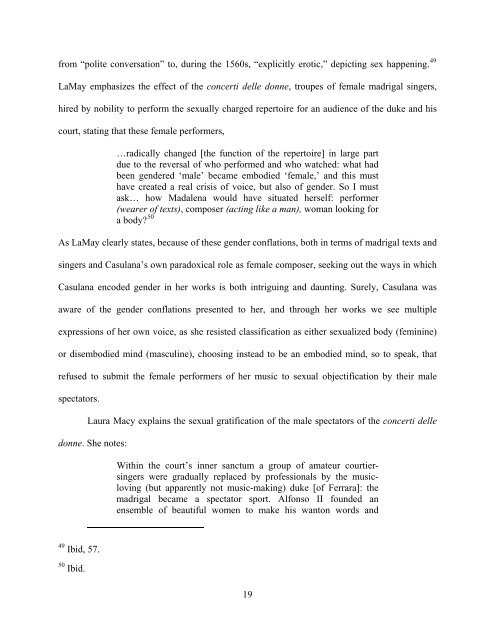Download - D-Scholarship@Pitt - University of Pittsburgh
Download - D-Scholarship@Pitt - University of Pittsburgh
Download - D-Scholarship@Pitt - University of Pittsburgh
You also want an ePaper? Increase the reach of your titles
YUMPU automatically turns print PDFs into web optimized ePapers that Google loves.
from “polite conversation” to, during the 1560s, “explicitly erotic,” depicting sex happening. 49<br />
LaMay emphasizes the effect <strong>of</strong> the concerti delle donne, troupes <strong>of</strong> female madrigal singers,<br />
hired by nobility to perform the sexually charged repertoire for an audience <strong>of</strong> the duke and his<br />
court, stating that these female performers,<br />
…radically changed [the function <strong>of</strong> the repertoire] in large part<br />
due to the reversal <strong>of</strong> who performed and who watched: what had<br />
been gendered ‘male’ became embodied ‘female,’ and this must<br />
have created a real crisis <strong>of</strong> voice, but also <strong>of</strong> gender. So I must<br />
ask… how Madalena would have situated herself: performer<br />
(wearer <strong>of</strong> texts), composer (acting like a man), woman looking for<br />
a body? 50<br />
As LaMay clearly states, because <strong>of</strong> these gender conflations, both in terms <strong>of</strong> madrigal texts and<br />
singers and Casulana’s own paradoxical role as female composer, seeking out the ways in which<br />
Casulana encoded gender in her works is both intriguing and daunting. Surely, Casulana was<br />
aware <strong>of</strong> the gender conflations presented to her, and through her works we see multiple<br />
expressions <strong>of</strong> her own voice, as she resisted classification as either sexualized body (feminine)<br />
or disembodied mind (masculine), choosing instead to be an embodied mind, so to speak, that<br />
refused to submit the female performers <strong>of</strong> her music to sexual objectification by their male<br />
spectators.<br />
Laura Macy explains the sexual gratification <strong>of</strong> the male spectators <strong>of</strong> the concerti delle<br />
donne. She notes:<br />
49 Ibid, 57.<br />
50 Ibid.<br />
Within the court’s inner sanctum a group <strong>of</strong> amateur courtiersingers<br />
were gradually replaced by pr<strong>of</strong>essionals by the musicloving<br />
(but apparently not music-making) duke [<strong>of</strong> Ferrara]: the<br />
madrigal became a spectator sport. Alfonso II founded an<br />
ensemble <strong>of</strong> beautiful women to make his wanton words and<br />
19















